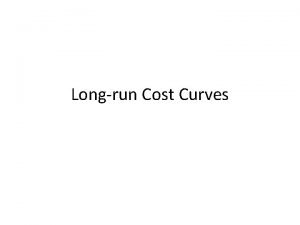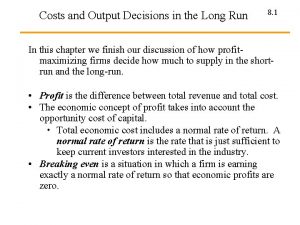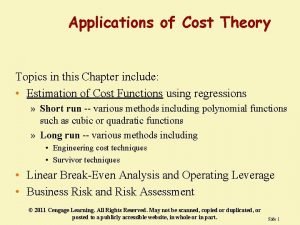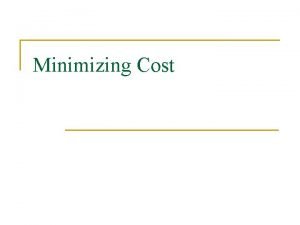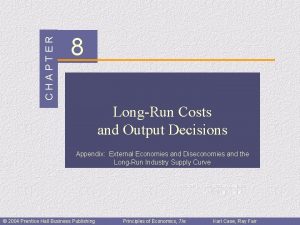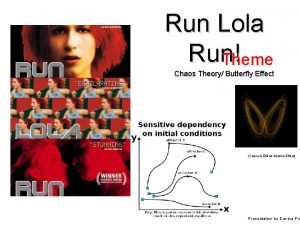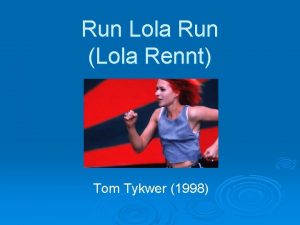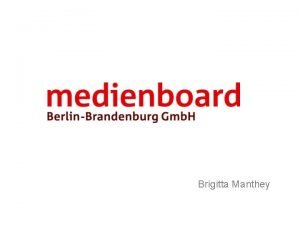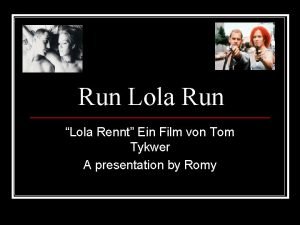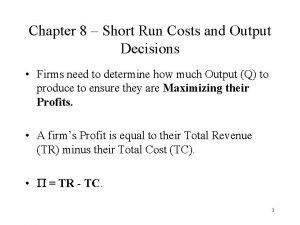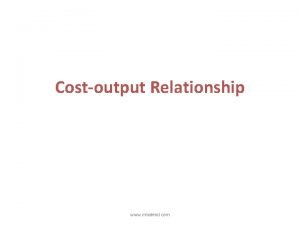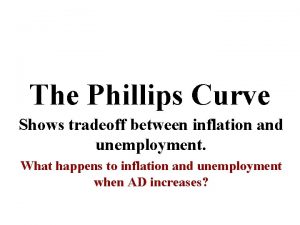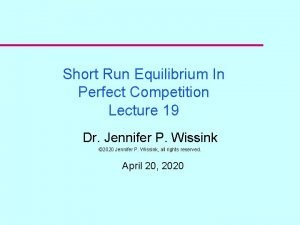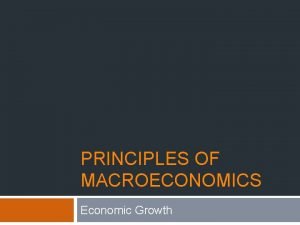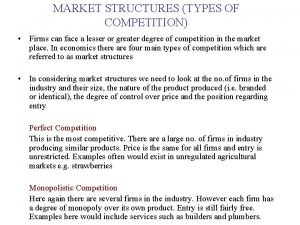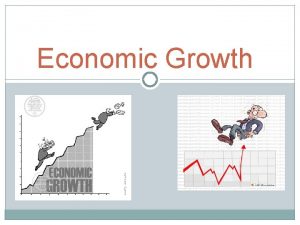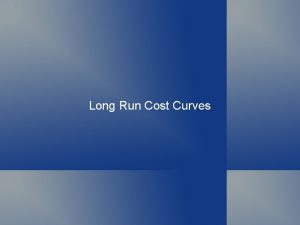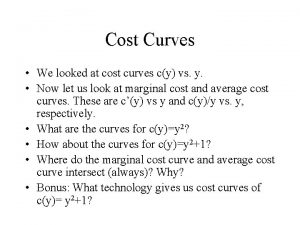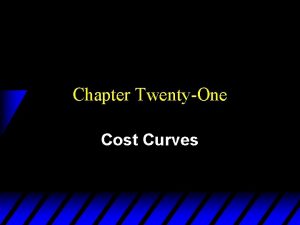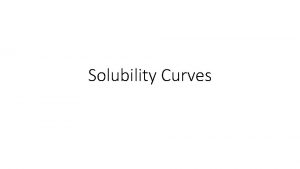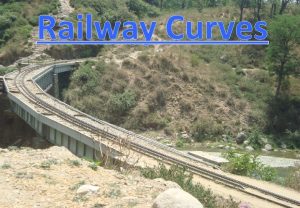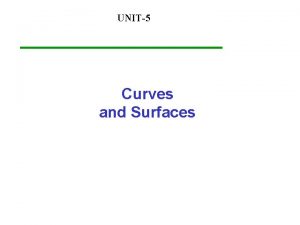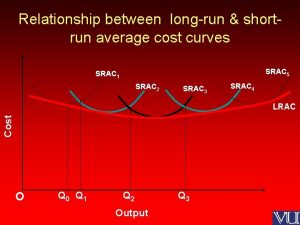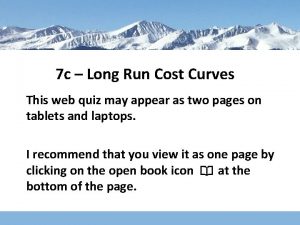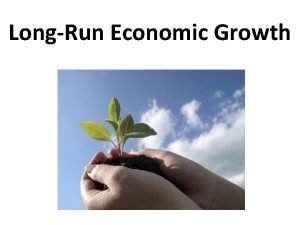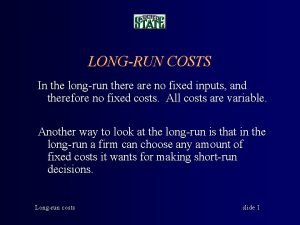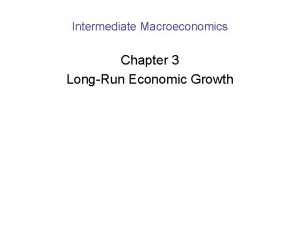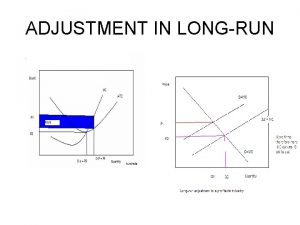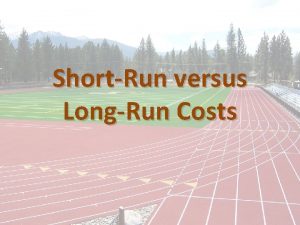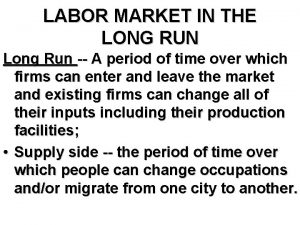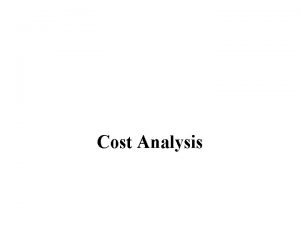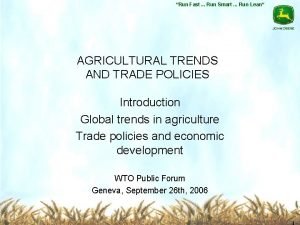Longrun Cost Curves The Long Run In the
























- Slides: 24

Long-run Cost Curves

The Long Run • In the short run, with a predetermined output level and only one factor variable, there is only one technically possible way of achieving that output. • In the long run, all factors are variable. There is an additional decision to make regarding how to produce the predetermined output level. • The firm has to make a choice from the many technically possible methods by which the desired output level will be produced. • The firm has to decide to adopt a technique that uses much capital and little labour or one that uses less capital but more labour. • Firms make such decisions using the simple rule of cost minimization- where the firm chooses the least costly method of production from the alternatives open to it.

The Principle of Substitution •

• If the LHS is greater than the RHS, then the firm will substitute more capital units for labour units since and additional cedi spent on capital produces more output than labour • For example: What substitution would the firm make if capital costs ghc 10 a unit and has a marginal product of 40 units of output while labour costs ghc 2 a unit and has a marginal product of 4 units of output. Discuss.

Discussion Question • Suppose that a firm is producing where the cost minimizing condition is met but the cost of labour increases while the cost of capital remains unchanged. What will the firm decide in terms of substituting one input for the other.

• The least cost method of producing any output will now use less labour and more capital than was required before the factor prices changed.

Making Long-Run Production Decisions • To make their long-run decisions: – Firms look at costs of various inputs and the technologies available for combining these inputs. – Then decide which combination offers the lowest cost. • The firm makes long-run decisions on the basis of the expected costs and expected usefulness of inputs. • To make long run decisions, the firm considers two main types of efficiencies- technical and economic

• Technical efficiency – as few inputs as possible are used to produce a given output. • Technical efficiency is efficiency that does not consider cost of inputs. • Economically efficient – the method that produces a given level of output at the lowest possible cost. • It is the least-cost technically efficient process.

The Long Run Cost Curves • In the long run, a firm has many sizes to choose from. • The short run requires that scale be fixed— only one or a few resources can be changed.

The Shape of the LRAC • The law of diminishing marginal productivity does not hold in the long run. • All inputs are variable in the long run. • The shape of the long-run cost curve is due to the existence of economies and diseconomies of scale.

Economics of Scale •

What is the difference between decreasing economies of scale and diminishing marginal returns?

• Most industries experience both economies and diseconomies of scale. • The minimum efficient scale (MES) is the minimum point of the long-run average-cost curve • the output level at which the cost per unit of output is the lowest.

Long-Run Average Total Costs of Total Costs = Labor Machines TCL + TCM Quantity 11 12 13 14 15 16 17 18 19 20 $381 390 402 420 450 480 510 549 600 666 $254 260 268 280 300 320 340 366 400 444 $635 650 670 700 750 800 850 915 1, 000 1, 110 Average Total Costs = TC/Q $58 54 52 50 50 51 53 56

Costs per unit Long-Run Average Total Cost Curve $64 62 60 58 56 54 52 50 48 Average total cost Minimum efficient level of production 11 12 13 14 15 16 17 18 19 20 Quantity

Costs per unit Economies and Diseconomies of Scale $64 62 60 58 56 54 52 50 48 Economies of Scale Constant returns to Scale Diseconomies of Scale Average total cost 11 12 13 14 15 16 17 18 19 20 Quantity

Graphing the LRATC Curve Figure 5 Long-Run Average Total Cost Dollars ATC 1 $4. 00 ATC 0 3. 00 ATC 2 C D B A 2. 00 LRATC 3 E 1. 00 0 30 Use 0 automated lines 17 90 130 160 184 175 196 Use 1 automated lines 250 Use 2 automated lines 300 Use 3 automated lines Units of Output

The Shape of LRATC • Economies of scale - LRATC decreases as output increases – LRATC curve slopes downward • More likely to occur at lower levels of output • Spreading costs of Lumpy inputs • Diseconomies of scale - LRATC increases as output increases – LRATC curve slopes upward • More likely at higher output levels 18

The Shape of LRATC • Constant returns to scale - LRATC is unchanged as output increases – LRATC curve is flat • U-shape of LRATC curve – Economies of scale at relatively low levels of output – Constant returns to scale at some intermediate levels of output – Diseconomies of scale at relatively high levels of output – The long-run and the short-run average cost curves have the same U-shape, but the underlying causes of these shapes differ. 19

The Shape Of LRATC Figure 6 The Shape Of LRATC Dollars $4. 00 3. 00 LRATC 2. 00 130 0 Economies of Scale 20 184 Constant Returns to Scale Diseconomies of Scale Units of Output

The Envelope Relationship • Long-run costs are always less than or equal to short-run costs because: • In the long run, all inputs are flexible • In the short run, some inputs are fixed • There is an envelope relationship between long-run and short-run average total costs. Each short-run cost curve touches the longrun cost curve at only one point.

SRAC and LRAC

Technology and Innovation • In the long run, technology is assumed to be fixed. In the very long run however, technology may change. • Changes in Technology is as a result of inventions and innovations. • Invention and Innovation of new and improved ways of production increases the productivity of inputs which also leads to reduced cost of production. • The increased productivity of inputs imply that the same quantities of inputs may then produce a different quantity of output than before.

Reading Assignment • Read on Technology and Innovation • Urge to merge…
 Lratc curve
Lratc curve Perfect competition long run equilibrium
Perfect competition long run equilibrium Short run vs long run economics
Short run vs long run economics Perfect competition short run
Perfect competition short run Short run supply curve for a perfectly competitive firm
Short run supply curve for a perfectly competitive firm Cost output relationship in long run
Cost output relationship in long run Cost minimization problem
Cost minimization problem Long run cost and output decisions
Long run cost and output decisions Long and short
Long and short Once upon a time, there
Once upon a time, there Từ ngữ thể hiện lòng nhân hậu
Từ ngữ thể hiện lòng nhân hậu Themes in run lola run
Themes in run lola run Run lola run editing techniques
Run lola run editing techniques Multirule plus
Multirule plus Brigitta olsen
Brigitta olsen Nnlolas
Nnlolas Short run cost and output decisions
Short run cost and output decisions Cost output relationship in short run
Cost output relationship in short run Shifters of lrpc
Shifters of lrpc Phillips curve graph
Phillips curve graph Supply curve under perfect competition
Supply curve under perfect competition Long run economic growth
Long run economic growth Long run supply curve
Long run supply curve Monopolistic competition in long run
Monopolistic competition in long run Long run economic growth
Long run economic growth
